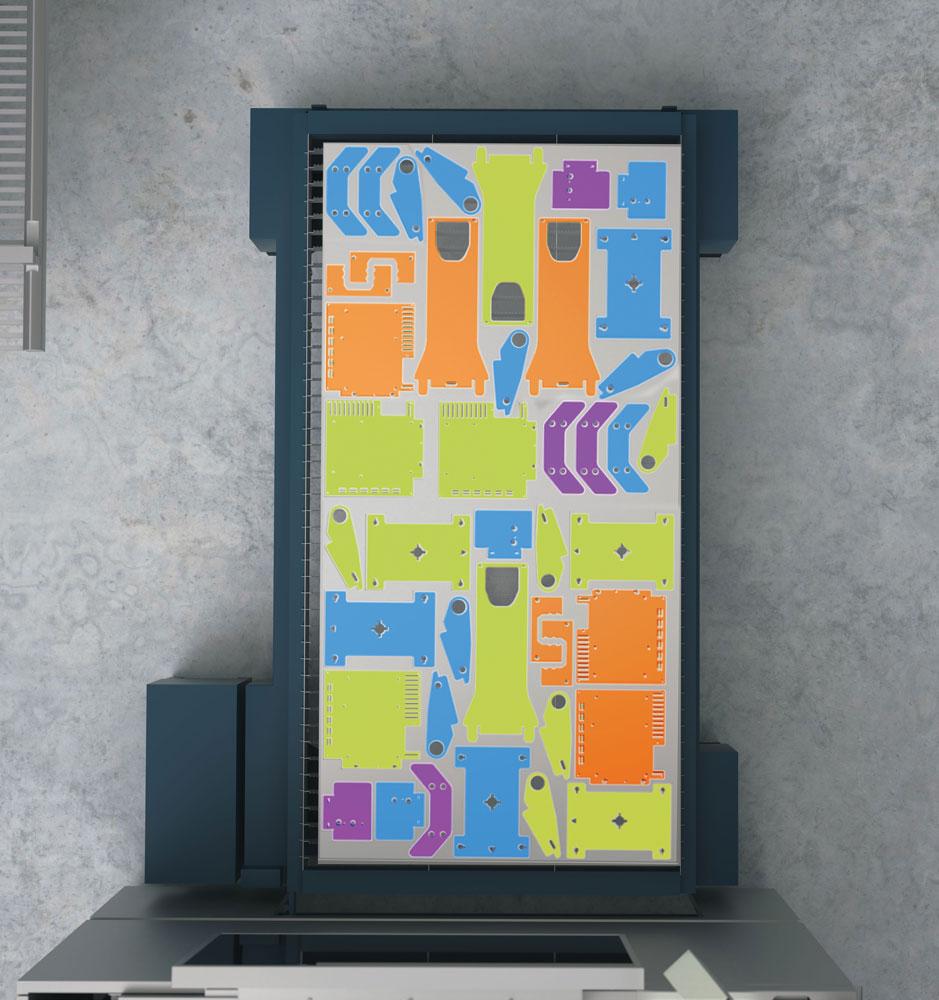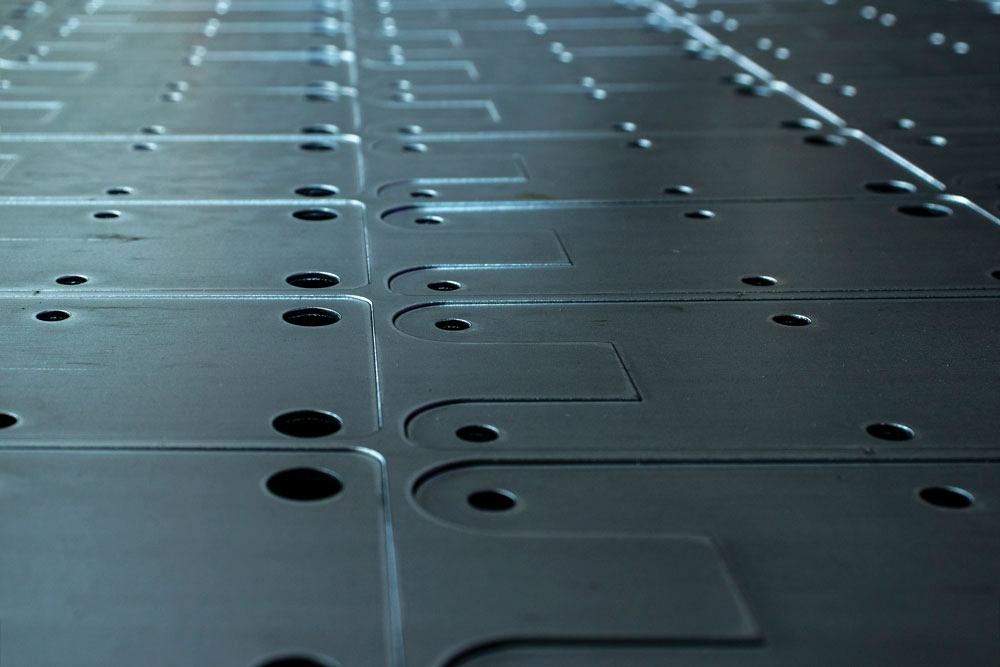Editor
- FMA
- The Fabricator
- FABTECH
- Canadian Metalworking
Material management for your fibre laser
Machine advancements and automation help shops keep scrap to a minimum
- By Rob Colman
- November 2, 2022
- Article
- Fabricating
Remnant management has changed since the advent of fibre lasers and the rise of dynamic nesting, advanced programming, and production control software. These technologies have made it easier to keep scrap to a minimum and give programmers and operators options in terms of how to manage materials. They haven’t removed remnants from the fabricating equation completely, but they have made it easier to prevent them.
These, in combination with other technologies, have made it easier to manage and use the remnants shops still generate.
Using Standard Sheet Cuts
“When turret punch presses were still the primary blanking option for fabricators processing sheet stock, the ability to dynamic nest, bringing in a wide variety of parts based on material type or thickness, was not always conducive. This is due to the amount of tooling and sequencing required to create the nest quickly,” said Matt Milazzo, laser product manager, AMADA AMERICA. “As fibre laser technology has become the go-to cutting option for many fabricators, dynamic nesting has become a valuable tool in programming and processing high-mix parts quickly. In combination with automated systems for material handling, it is helping fabricators become more efficient while maximizing material usage.”
Lasers often enable high material use, minimizing costs, and, in many cases, avoid remnant creation.
“Laser programming to create code for any number of parts and geometry based on a particular material type and thickness has become common,” said Milazzo. “Customers are looking to dynamically nest parts not based on a particular order, but rather based on a particular material type, thickness, material utilization, and due date. Build requirements covering a variety of customers or assemblies can be processed together. Customers can enable the software to populate a sheet to use the material as efficiently as possible. ‘Rules’ within the software, such as meeting a particular material utilization prior to creating the nest for production, can prove beneficial.”
“In many instances, the use of dynamic nesting has enabled customers to minimize the different number of sheet sizes that they must keep in inventory, reducing material costs. There are many examples of customers embracing these methods, whereas customers running single or multiple laser systems never run the same nest throughout a given day.”
The only issue that can arise with running parts for multiple orders in the same nest can be in the sorting process and ensuring that parts are channeled correctly from there. Of course, machine builders are coming up with ways to help manage this as well.
“With one software, a shop can track the full production workflow of their orders,” said Kevin Cuseo, software product sales engineer, TRUMPF North America. “Using the software via PCs and tablets with web apps, you can use our Oseon software to give personnel on the shop floor customized access to processes. If we’re talking about a full sheet of parts from multiple orders, you’d have an operator responsible for removing parts from a skeleton, and their tablet would show them an overview of what that nested sheet looks like, and what parts are on it, and how they should be routed from there.”
So, in this case, with a full sheet, it would help sorting through separate orders.
Filler Part Possibilities
If customers want to embrace dynamic-type nesting while keeping material utilization high, then automatically filling unused areas of the sheet with filler parts is another option.

The only issue that can arise with running parts for multiple orders in the same nest to avoid remnants can be in the sorting process and ensuring that parts are channeled correctly from there. Of course, machine builders are coming up with ways to help manage this as well. For instance, TRUMPF’s Oseon software gives shop floor personnel customized access to processes. In this image we see how the company’s Sorting Guide can help operators properly pick and place multiple orders from one sheet. TRUMPF
“Say we’re making electrical cabinets and we know that multiple pieces of a particular bracket are going to go into every assembly,” said Milazzo. “We can designate multiple different part numbers as filler parts. In this instance, you can optimize material utilization while enabling the software to track the quantities of filler parts produced. As an example, you could pre-set the count on that particular bracket to, say, 500 pieces; if the software could not reach your minimal material utilization value, the software will automatically populate the unused areas of the sheet with as many of the “filler” brackets that it can to meet your utilization criteria and proceed to create that nest. The software will count down from your pre-set value as filler parts are automatically inserted into your production schedule. We can manage any number of parts, quantities, and geometries associated with filler parts and ultimately minimize the creation of remnants while maximizing sheet utilization.”
The other benefit of processing full sheets, Milazzo noted, is that it typically keeps the laser “beam-on time” longer, which can help balance the time it takes for the automation to cycle while the laser cuts.
The Flexible Stock Option
But some shops like consistency and don’t want to manage work in process (WIP) on the shop floor. In this case, Milazzo notes that “kitting” a group of parts that make up a particular assembly or subassembly can be a valuable option.
“In this case, it may make sense to order a custom-sized sheet so that you maximize material while producing complete “kits” of parts each time the program is run,” he said.
For those shops that do stock different sheet sizes and wish to process specific customer orders separately using more than one sheet size, the technology today is robust enough to manage it.
“For instance, with our TruTops Boost software’s lean nest engine, coupled with our raw sheet management abilities, we can use different sheet sizes on a run to avoid unnecessary scrap,” said Cuseo. “It’s just a matter of telling the software, ‘Make me a nest that produces the least amount of scrap as possible so I can avoid remnants as much as possible.’”
When Remnants Make Sense
Cuseo noted that with regularly used materials, sometimes a looser nest makes more sense in terms of overall productivity than using every last inch of that sheet.
“You might create a rule that says, ‘I’d rather spread parts out by a wider margin to make it easier to manage the part picking process,’” he said.
But sometimes with more expensive materials, a shop will want to squeeze all they can get out of a sheet and save remnants that can’t be used immediately for later work. This is another place where software can help.
“Say we’re using 7 ft. of a 10-ft. sheet,” said Milazzo. “Our software has the ability to recognize that remnant and create an inventory of how many remnants of that size we have. Similarly, if we are running prototype parts on a sheet and have a usable area left over, the software can dictate to the laser to cut the unused portion and etch the remaining sheet size.”

Recently, some machine builders have introduced camera systems into their machines to create a setup by which parts can be dragged and dropped onto remnant sheets for quick processing. Here we see AMADA’s i-CAS camera system being used by the operator to drag and drop parts onto the remnant. AMADA AMERICA
Cuseo noted that a number of parameters can be created for how remnants can be cut. For instance, the size of the remnants can be standardized to further assist with management on the floor.
And with operators equipped with tablets on the shop floor, the operator responsible for removing parts will see if there are any remnants on the sheet he is processing and be able to label and properly store it.
“The laser can etch and cut the remnants to I.D. them as necessary, but having that ability in the hands of the operator creates further clarity and simplifies the management process,” Cuseo said.
Many automation options exist today to supplement laser processing and can simplify where remnants are stored and allow for easy access to them for later use. In addition, automated systems maximize laser processing time and can play a large role in ensuring you are getting the most out of your investment, maximizing efficient use of time and materials.
Effective Remnant Use
Actually using those remnants efficiently has, in the past, been a challenge itself; programming for a partial sheet may not take a great deal of time, but it can seem to be more trouble than it’s worth in a fast-paced fab shop.
Recently, some machine builders have introduced camera systems into their machines to create a setup by which parts can be dragged and dropped onto remnant sheets for quick processing.
“This type of technology really simplifies post-process redoing of parts or adding extra parts to an order,” said James Gamache, TruLaser sales engineer, TRUMPF North America. “It saves you having to go back to programming because it is all done at the controls.”
“Both our REGIUS and BREVIS laser offerings include the i-CAS camera system, which creates an accurate image of the remnant or sheet as it is positioned atop the slat table, including any previous parts that may have already been cut,” said Milazzo. “Various parts displayed on the AMNC 3i control can then be dragged and dropped onto the remnant image. You can then easily grid the part to a desired quantity or insert additional parts as required.
“Another aspect to our machines that make this option effective is that you can access the cabin on two sides, making it simple to place a remnant on the bed.”
The BREVIS is a newer 3-kW fibre laser with a small physical footprint. It has a 50- by 50-in. cutting area but can accept a 48- by 96-in. sheet.
“The BREVIS lends itself well to the i-CAS camera system for placing parts easily on remnants,” said Milazzo. “If, as an example, a part is bent incorrectly, quantities were inaccurate/misplaced, or parts damaged in some other fashion, it may make sense to run small quantities of replacement parts on a compact machine like the BREVIS rather than interrupting green-light-on time on a larger, automated cell.”
The key for shops is that there are software systems and machine designs that are adaptable for the way in which they wish to work. Whichever approach a shop takes, processing productivity and effective remnant management is within reach.
Editor Robert Colman can be reached at rcolman@canadianfabweld.com.
AMADA AMERICA Inc., www.amada.com/america
TRUMPF Inc., trumpf.com
About the Author

Rob Colman
1154 Warden Avenue
Toronto, M1R 0A1 Canada
905-235-0471
Robert Colman has worked as a writer and editor for more than 25 years, covering the needs of a variety of trades. He has been dedicated to the metalworking industry for the past 13 years, serving as editor for Metalworking Production & Purchasing (MP&P) and, since January 2016, the editor of Canadian Fabricating & Welding. He graduated with a B.A. degree from McGill University and a Master’s degree from UBC.
subscribe now


Keep up to date with the latest news, events, and technology for all things metal from our pair of monthly magazines written specifically for Canadian manufacturers!
Start Your Free Subscription- Industry Events
Automate 2024
- May 6 - 9, 2024
- Chicago, IL
ANCA Open House
- May 7 - 8, 2024
- Wixom, MI
17th annual Joint Open House
- May 8 - 9, 2024
- Oakville and Mississauga, ON Canada
MME Saskatoon
- May 28, 2024
- Saskatoon, SK Canada
CME's Health & Safety Symposium for Manufacturers
- May 29, 2024
- Mississauga, ON Canada






















